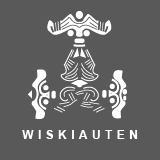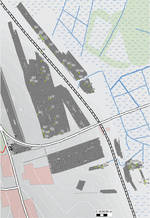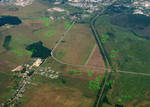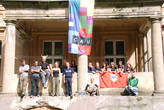Results of the investigations of 2008
In 2008 two field research activities were carried out. Already in March new areas with an extension of 30 ha were examined by geomagnetical methods. The measuring concentrated on the former coastline of the supposed lake in the east of the barrow cemetery of Wiskiauten.
Only here, on the shore of this swampy area, harbour facilities make sense and can be expected (Fig. 1). As usual the pictures showed lots of anomalies again. Parallel to the measuring some of these anomalies were checked by drillings, followed by regular excavations in summer 2008 (Fig. 2).
The excavations in summer took part from the 16th of July until the 25th of August and was carried out by the Archaeological State Museum of Schleswig in cooperation with the Archaeological institute of the Russian Academy of Sciences in Moscow respectively their “Baltic Expedition”. Students of the universities of Kiel and Kaliningrad participated in the excavations (Fig. 3).
The investigations focussed on the area east of the barrow cemetery. On a length of 1000 m the landscape is descending smoothly to the former inland lake. Already in the past years the features of excavation areas 5 and 8 gave hints at a bigger dwelling site of the 6th to 8th cent. AD in this area.
To check this suggestion in the year 2008 altogether 12 little excavation trenches were conducted. Six of them are situated in the supposed dwelling site in the east.
Whereas excavation areas 11 and 15 were free of archaeological objects in the areas 14 and 16 small grey coloured features occurred, containing only little amounts of charcoal.
One of these pits in area 16 by C14-analysis was dated to Neolithic times. The feature in area 14 remains undated.
In the excavation areas 12 and 13 a posthole and a ditch came to light, which by their dating into the 6th to 8th cent. AD give clear evidence of settlement activities, starting already before the supposed Scandinavian graveyard of Wiskiauten was taken into use. Still the duration of this dwelling site is unknown. In general traces of settlement activities also of the Viking Age can expected in this area as the results of several test pits (especially test pits 15 and 16), situated at the sandy peninsula “Palwe” directly on the shore of the former lake in the east, show. By C14-analysis the occupation layers, which were documented in these tespits, can be dated into the time span of the 7th to early 11th cent. AD.
Two excavation areas were conducted in the northeast in a distance of approx. 1 km north of the cemetery at the former coastline. No archaeological features were discovered here. Probably in this area humans did not settle in the first millennium AD.
Another focus of the fieldwork in 2008 lay on the area north and northwest of the barrow cemetery, where the excavation areas 19 and 20 examined clear geomagnetical anomalies. Each of these anomalies forms part of a bigger concentration of geomagnetical anomalies in their vicinity which were already dated during the previous investigation. The new data fits perfectly to the former results. In area 20 a huge fireplace with a length of 2 m was unearthed. It can be dated into the second half of the first millennium AD. In opposite in area 19 a big feature of the 12th cent. AD came to light. It was unearthed only partly and is preliminary interpreted as a well or a cellar.
To summarize the presumption of a bigger settlement area in the east of Wiskiauten between “Palwe” and excavation area 8 of the year 2007 gained clearer evidence. Dwelling sites of this time are nearly unknown in the Kaliningrad Region which is why bigger excavations, planned here for the following campaign in 2009, could bring new results for the development of urbanization processes between the Migration Period and Early Medieval Times for the whole region. Especially test pits 15 and 16 show the general possibility of finding archaeological features of the 9th and 10th cent. AD in this zone.
But also in the Northwest of the graveyard Wiskiauten can be expected a dwelling site of the second half of the first millennium AD around excavation area 20.
In opposite the fields between Wiskiauten itself and the village Vishnevoe/Wosegau seems to be covered by archaeological features of the 12th and 13th cent. AD. Excavation area 19 gave new evidence to this theory. These tracks of human activity most probably can be combined with the local Prussians and the house structures unearthed in excavation area 4 already in the year 2006 and further more to the Prussian flat graves situated in the east of the barrow cemetery. Excavations in this area north of the graveyard might be profitable as well and should be carried out in future having regard to plans of the local administration to build a big hotel area here.
[top]




